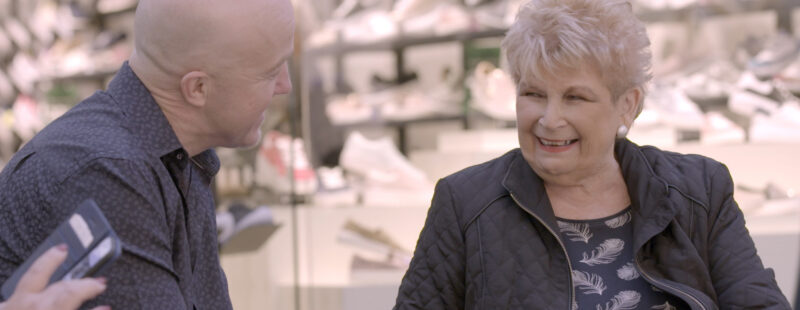Dr. Gillian Sandstrom is a social psychologist at the University of Sussex. Read her tips on how to talk to strangers as a way to help end loneliness.
Getting started
Do you like the idea of chatting to strangers as a way to tackle loneliness? Do you worry that you don’t know how to do it? Good news: it’s not as hard as you think and you’re already better at it than you think!
First things first: start a conversation. There are lots of ways to do this, and I urge you to experiment. First you can comment on something you have in common, starting with the old classic, the weather! You can also chat about shared location, or something you’re both looking at. This may seem trivial, but you only need to make that initial connection before moving on to more interesting topics.
Another option is to start with a compliment. It’s fun to deliver compliments, and even better to receive them, especially from a stranger. Compliments can be easier to believe when they come from someone who doesn’t know you.
You can also use your observational skills to tap into your curiosity to ask questions, or ask for advice.
I’ve asked people why they were wearing airplane earrings, what race their t-shirt was for, what book they were reading. I often combining my observations with humour. I once commented on a young man’s ‘breakfast of champions’ (a packet of biscuits). That same day, I asked two Freemasons wearing matching striped trousers if they had coordinated that morning!
Following through
Now that the conversation is rolling, here are some tips for how to keep it flowing smoothly. Comment on things you have in common, and use your observational skills and curiosity. People like it when you ask follow-up questions. It demonstrates that you are listening, rather than thinking of what to say next.
You might consider disclosing something about yourself, which demonstrates trust and encourages reciprocation.
I once started a conversation with a lady on the Tube by asking her how her day had been going so far. She gave a non-committal response and I thought the conversation might be over. Then she asked me the same question, and I told her that I’d been on an adventure (being interviewed on BBC Radio 4!) She then confided in me that she had only found out she was pregnant! She was heading back to work and was going to pretend nothing had happened as she wanted to tell family and friends first. Yet she felt safe telling a stranger on the Tube, who she would never see again. I felt so honoured!
Finally, it’s important to be patient. You may surprise people by talking to them, and it may take them a while to adjust to the idea that you’re only being friendly. Keep going, and most of the time you’ll manage to get into a groove.
How to end it
It’s important to note that no conversation can last forever, so when it’s time for you to move on, you need to figure out how to end the conversation. In my workshops on ‘How to Talk to Strangers’, people always come up with loads of ways to start conversations. What they struggle with are ways to end them without lying (or making unnecessary trips to the loo)! That could be why people don’t talk to the person next to them on the airplane until 15 minutes before it lands when you can guarantee it’s going to end.
Research confirms the challenge: conversations almost never end at a time when both parties want it to end. When you’re ready to move on, tell the other person that it’s time for you to be on your way, and that you’ve enjoyed the chat (which I’m sure you will have!)
If all this talk of starting, maintaining, and ending conversations makes chatting sound like a lot of work, don’t worry! Like most skills, you can learn and develop social skills. I would consider my Dad a world expert in talking to strangers, but his school friends say he was quite introverted back in the day. Similarly, I used to walk around with my eyes on the ground – it’s pretty hard to start a conversation without eye contact! But now I talk to people even on the Tube! Once I started talking to strangers I realized how much fun it could be and started doing it more often.
In a recent research study, my colleagues and I asked participants to talk to at least one new person every day for a week. At the end of the week many of our participants admitted that talking to strangers was easier than they thought. “I can honestly say that I’m not nearly as shy as I thought! This experiment allowed me to push out of my comfort zone and take the initiative when talking to people.”
Not only will you start to feel more comfortable with practice, but you’re already better at it than you think. If you’re like most people, after chatting to a stranger you can’t help but wonder what they thought about you, and your conversation. Research shows that people generally underestimate how much others like them. This is the case before an upcoming chat to a stranger, after a chat to a stranger (long or short), and even after living with a flatmate for several months.
Stranger danger
Unfortunately, “stranger danger” norms are more common than “Be More Us”, so sometimes people won’t want to talk to you. This happens a LOT less often than you would think. We conducted a week-long study. Participants responded: “I was worried people would prefer to be left alone, but that was never the case”, and “I did have some awkward moments where I did not know how to continue the conversation because I just did not know enough about the person or the person did not seem as enthusiastic but I was never turned down by anyone.” If someone doesn’t want to talk, remember that they may be nervous too, or reading a really good book. It’s rarely a judgement of you. It’s better to respect their decision and try again with someone else. You’ll find plenty of people who are more receptive and appreciative.
So, be brave, and start a conversation with someone. You’re more capable than you think, and both of you are likely to enjoy it more than you expect.
Visit Gillian Sandstrom’s website to find more resources on how to talk to strangers.





No comments on this article yet. Please feel free to submit a comment below.
By submitting a comment you grant Campaign to End Loneliness a perpetual license to reproduce your words and name/web site in attribution. Inappropriate and irrelevant comments will be removed at an admin's discretion. Your email is used for verification purposes only, it will never be shared.